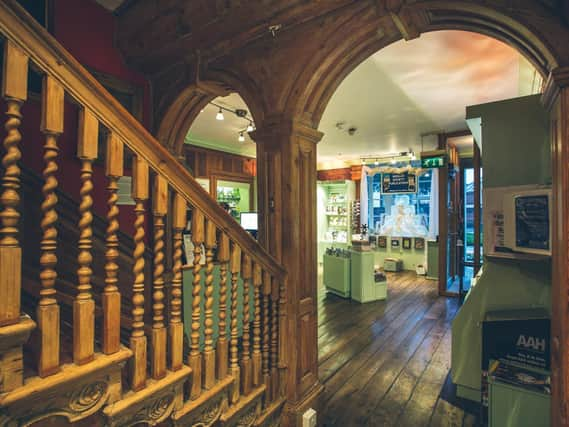New book tells the story of Horsham Museum's building


Museum spokeswoman Rachel Weller said: “The past is often hidden in plain sight waiting to be discovered. How many of us have walked past 9 Causeway and thought ‘That’s an old building’ without any deeper consideration?
“In order to rectify this oversight Jeremy has told the story of the building in a new, exciting book Causeway House: A Biography of a Horsham landmark.
Advertisement
Hide AdAdvertisement
Hide Ad“Known today as the home of Horsham Museum, our historic building has been on this site for 600 years and, as the book reveals, it has had an eventful life!
“From being the home of the Tudor equivalent of a celebrity, giving its occupants the right to vote for six MPs, to having a fake past deliberately created, Causeway House has been the home of merchants, lawyers, a royal tutor, a tailor’s daughter who went from being the subject of a scandal to a wealthy heiress and much more.
“The origins of Causeway House lie in a lost building that was erected as Horsham was developing into a bustling market town.
“Next to this all-in-one building a modern timber framed home and workplace was erected.
Advertisement
Hide AdAdvertisement
Hide Ad“Three of that building’s original sections still survive, and their stories have been uncovered by building archaeologists. The wooden remains tell us that this new building was erected around 1420, a time when Horsham was rising in the league table of wealthy Sussex towns. Some 25 years later a new market would be established by the Archbishop of Canterbury in Lower West Street (today’s Bishopric). The rising wealth of Horsham can be seen in the changes to the building, such as the construction of a kitchen.
“Causeway House: A Biography of a Horsham landmark does not only look at the architecture of the building, but also relates it to the lives of those who lived and worked there. In today’s COVID-19 world the home has become a multifunctional space, a place for work, rest and play, just as it was 500 years ago when a merchant owned Causeway House.
“The word merchant has a Shakespearian glow about it and it should, for in Elizabethan England a merchant was the nearest thing they had to today’s celebrities. Merchants were people of status. It was a trade that many people aspired to as it was a job in which someone could grow wealthy. Today we may not trust what a celebrity says, although many do, but in Tudor times the merchant’s word was his bond. It was this type of man who lived in Causeway House and adapted it to his status in life. This included the creation of a whole new building that now faced the Causeway, rather than facing north.
“By late Georgian times Causeway House had seen many changes, relics of which exist still exist today, from the addition of a grand staircase, the upgrading of oak panelling to walnut, to re-arranging the rooms. Into this grand house stepped Sarah Smith, the widow of General Smith. She was brought up only a few meters away and had eloped with the far older Captain Smith, causing much consternation in the street.”
Advertisement
Hide AdAdvertisement
Hide Ad“After his death, Sarah returned to Horsham and set up home in 9 Causeway as a wealthy heiress. As a woman she could not use the right to vote for the six local MPs that male owners of Causeway House had, a right that didn’t disappear till 1832.”
Rachel added: “The colourful book is full of unusual pictures and photographs of both the house and its setting; from an 18th-century etching of a 14th-century map of Britain that put Horsham on the map, to a watercolour by volunteer museum gardener Heather Glenny of a fig leaf from a tree grown from a cutting of the fig and walnut walk that adorned the extensive 17th century garden. There are unusual photographs such as one that shows the Causeway as the town’s first official car park back in the 1920s, as well as images of the architectural features hidden in the roof spaces.
“Causeway House became home to the Museum during the Second World War, and as late as 1983 it stopped being a residence. The book, written by the current curator, is a visual delight.
“Entertaining without being heavy going, it is packed full of interesting stories. Published to mark the 600th birthday of the building Causeway House: A Biography of a Horsham landmark reveals a building hidden in plain sight.”
Advertisement
Hide AdAdvertisement
Hide AdPriced at £7.50 plus postage. To order your copy, email [email protected] or contact the museum on 01403 254959. Also available at Waterstones in Horsham.
Advertisement
Hide AdAdvertisement
Hide Ad• Talk is increasing of further lockdowns in the UK. What do you think of the situation? Join the Big Conversation and have your say on everything from healthcare to how the pandemic has affected you personally and how we make our communities stronger: https://www.surveymonkey.co.uk/r/bc-worthing
Comment Guidelines
National World encourages reader discussion on our stories. User feedback, insights and back-and-forth exchanges add a rich layer of context to reporting. Please review our Community Guidelines before commenting.